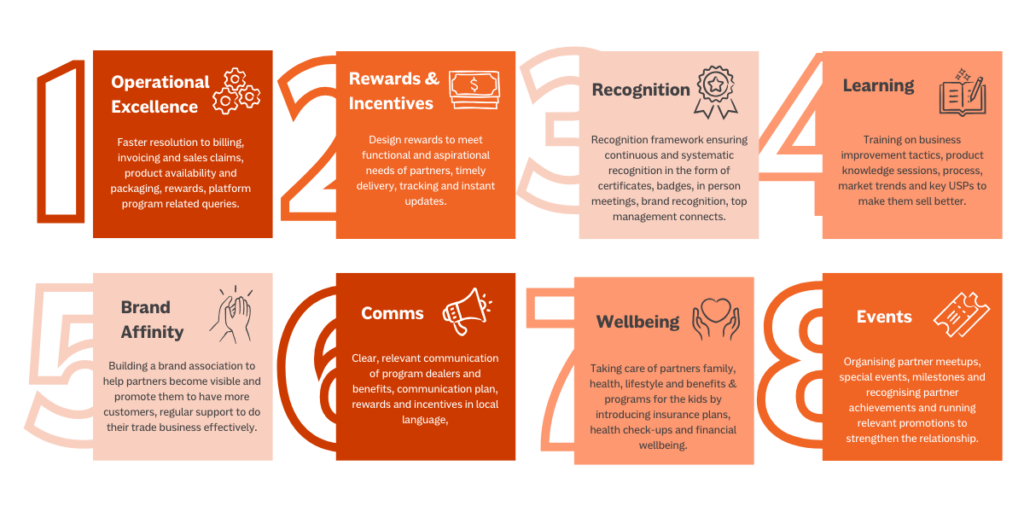Whether your channel incentive objective is stretching the top 20% of performers or driving incremental performance of the middle ground, the engagement of your target audience is the first challenge that any channel incentive designer must overcome.
A common assumption is that this is simply achieved by curating the right reward selection. After all, the right attractive and attainable reward is an essential attention-attracting currency and will create that initial spark to act where the motivation to do so might be low. However, many times we hear from clients that the engagement and the physical actions taken by participants to meet the objectives set are still low, even with the right reward strategy in place. From our experience, whilst rewards are a critical component in engaging your channel, they will only take you so far!
The drivers of channel incentive engagement
BI WORLDWIDE Canada conducted a study in association with KANTAR to understand and analyze what engages and motivates channel partners to give their best. Through this research, we identified eight drivers of engagement. Surprisingly, rewards were not the primary engagement driver. Instead, channel incentives and rewards came in second to operational excellence.

What is operational excellence?
When processes and systems are fragmented or goals and objectives are unaligned or unattainable, this creates friction, which leads to disengagement and reduced performance. What the research revealed was channel partners are looking for simplicity, an ease to doing business and for the good performance indicators to harmonize with things they can do within their day-to-day role as much as possible.
How do we improve operational excellence to increase channel incentive engagement?
Gamification can be an effective motivation technique. Breaking down tasks into attainable goals and nudging completion. But used incorrectly, it can often be a culprit of damaging operational excellence and the desire for simplicity. Effective implementation means understanding there is a fine line between tactics that engage and enable individuals through breaking down a task for them and introducing steps and creating unnecessary complications in a process.
Incentives are most effective when the individual feels they have a unique advantage, when the program has ‘idiosyncratic fit’. The benefits of incentives with idiosyncratic fit are that they reduce friction, build a sense of confidence, increase motivation, and improve performance.
A good example of this is successful wellness programs which help each participant by taking them on a personal journey, starting with their unique situation and implementing small attainable goals to nudge improvement, rather than a ‘one size fits all approach.
What influences idiosyncratic fit?
In behavioural economics terms, a rule structure that has high idiosyncratic fit is perceived by the participant to be perfectly suited to them. This is achieved through intelligent program design that offers personalized goals, segmented communications and inspirational rewards that make people feel like the opportunity being presented to them is unique, within the scope of their role, that they are equipped, and ready to act.
Personalized goals
- People like to believe their situation is unique, and they assess their uniqueness by comparing themselves to others. When setting objectives or goals, you will achieve idiosyncratic fit if objectives are based on personal, historical productivity.
- Self-selection of goals is an excellent way to introduce program personalization. By including an element of choice within your program, participants can decide for themselves what is achievable and to what level they want to be rewarded. Our patented sales incentive structure, GoalQuest® AI, is designed to harness this exact tactic through self-selected targets and rewards.
Segmented communication and incentive design
- Not all participants or channel partners are created equally or truly have equal opportunity to improve. Transformative program design segments the audience so different stages of the performance curve perceive the rules as fair. It is possible for each segment to play by its own unique set of rules.
- For example, typically, high performers are already near the top of their game, and their opportunity for linear growth is less. Lower performers must be engaged, and their ability measured. The percentage increases achievable by the low performers (50%, 100% or more) are impossible for the top performers, who might see stretch objectives of just 2% or 5% growth with but the objective for these partners may be focused on a deepening of their relationship with the vendor or driving breadth of skills.
- Attention is a currency. Overcome a person’s communication saturation by ensuring incentive messaging is targeted and timely. Aim for the right place, right time, vivid, personalized updates and calls to action to quickly capture attention.
Inspirational rewards
- Consider how success is measured and rewarded. Idiosyncratic fit can be achieved if;
- All members of a team earn the same value if the team qualifies or is rewarded with something that can be shared.
- Team members earn based on their role and contribution (objective, not subjective) to the initiative and/or…
- Individuals earn according to their own performance.
- Reward choice offers the best idiosyncratic fit as it acknowledges that motivation is personal and allows people to align how they are rewarded with their own aspirations and preferences.
- Achievements or badges are an effective way to recognize performance and showcase a unique advantage to the participant without significant expense. Badges are a great way to highlight someone’s President’s Club status or a performance milestone, for example.
- Note that reward value is particularly sensitive to income and perceived value on one hand and fairness on the other. Who earns what requires serious consideration.
Simplify and personalize your channel incentive program approach
In a cluttered landscape, capturing and sustaining attention can be a challenge for brands reaching end customers via indirect channels. Channel incentive programs are an effective way to enable your ecosystem, but to engage channel partners, above all else, brands must prioritize operational excellence.
Recognizing that we must be sensitive to channel partners’ needs in our program design will ultimately enable them to achieve better results for you, and increase their engagement, ultimately contributing to the program’s return on investment (ROI).
Maximize results by leveraging the drivers of engagement in channel incentives.
